and 2017
Walking, hiking and trekking on ANAFI
WALKS
(last update on the 15th of December 2020)
*** = very beautiful
**** = exceptional
+ Gpx = with Gpx-file
1.
Chóra - Agia Marína - Chóra
2. Chóra - Agios Nikólaos - Klisídi and back
3. Chóra - Katsoúni - Klisídi - Agios Nikólaos - Chóra
4. Chóra - Miliés - Kálista - Panagía tou Dókari - Roúkounas *** + Gpx
5. Chóra - Psáthi - Stavrós - Panagía Vouvoón and back + Gpx
6. Chóra - Roúkounas and back *** + Gpx
9. Moní Zoödóchou Pigís - Panagía Kalamiótissa and back **** + Gpx
10. Roúkounas - Megálos Potamós - Agii Anárgyri - Monastíri and back **** + Gpx
11. Roúkounas - Panagía tou Dókari - Kastélli - Agios Mámas - Monastíri and back **** + Gpx
Anáfi is a small island (38 km²), and also the most
southeastern island of the Cyclades. Because of this isolated location it has not yet been affected by
tourism, which contrasts sharply with the nearby island of Santoríni.
According to
mythology, the island "Anaphè" appeared from the sea by order
of the god Apollo, and this to offer a shelter to Iasoon and the Argonauts
after a heavy storm.
Because of the volcanic eruption in the year 1650 BC, which created the
present-day spectacular view of Santorini and its volcano, also at Anáfi
thin layers of pumice stone came down at certain places. Later on, the
history of Anáfi ran parallel to the history of the other Cycladic isles:
in the year 1207, for instance, it was also annexed by Marco Sanudo, the
king of the Latin-Venetian state of Náxos, and in the year 1537 it became
Turkish.
Because the island suffered a lot from invasions by pirates, it
depopulated almost completely – which still explains the absence of
terraces for agriculture and of donkey trails. In 1956 Anáfi met with the
same fate as Santoríni and it was almost entirely destroyed by the
earthquake.
The small island is
very mountainous with a relatively high summit: the Vìgla is
585m high. The interior is very dry, but still there are a couple
of deep and narrow valleys, remarkable because of the dense vegetation
consisting of all kinds of large cacti.
There are
only
a
few boat connections with Anáfi:
for the moment, there are
two
connections
a week
from the Piraeus, via
Mílos and
Santoríni,
to Anáfi. This boat (the Prevélis) then continues to Kássos, Kárpathos, Chalkí and Ródos.
The
Aqua
Jewel connects, twice
a week,
Anáfi with Santoríni,
Thirasiá, Ios, Síkinos, Folégandros, Náxos, Páros and Sýros.
The
distance from the Piraeus is 150 nautical miles, about 280 km, which means
that the crossing takes a long time – up to 12 -14 hours. Therefore, it
is more interesting to first take a fast boat from the Piraeus to Santoríni
and then you can cover the remaining 12 nautical miles to Anáfi in about
2 hours...
The harbour of Agios
Nikólaos is very small and it is connected with the main town of Chóra
by means of the only asphalt road. Because of its amphitheatre-shaped
location and also because of the wind mills on the slope of the hill,
Chora is really very picturesque and attractive. Striking is that most of
the houses, also the newer ones, are built with a vaulted roof – which
offers better resistance against earthquakes. Also remarkable are the
baking ovens, although these days they are only used sporadically. All
together there are only about 300 people living in these two villages.
The island also
offers a number of interesting archaeological sites. On the slope of the
Kastélli (325m) you can find the remains of the ancient Anaphè; a little
downwards there is the chapel of Panagía tou Dókari with a very nice
Roman sarcophagus in front of it.
No doubt the most impressive sites are the two monasteries on the eastern
point of the island: the monastery of Panagía Zoödóchou Pigís at the
foot of and the monastery of Panagía i Kalamiótissa on the side of the
450-metres high Kálamos. The large monastery of Zoödóchos Pigí is
built on the rests of the temple of Apollo and it has incorporated large
parts of the old temple wall in the new walls. The big festival (the Panigýri)
takes here place on the 8th of September. The high monastery of Panagía i
Kalamiótissa is marvellously situated on one of the summits of the Kálamos
(hence its name). The panoramic view in itself (sometimes all the way to
Crete, usually with all the surrounding Cycladics, whereby especially the
island of Amorgós with a view on the monastery of Panagía Chozoviótissa
is remarkable!) is worth the trip to Anáfi.
Anáfi also
possesses a couple of beautiful beaches on the south coast, with amongst
others the beach of Roúkounas (which is the longest one), the beach of
Klisídi (which is closest and which can be reached on foot) and the small
beaches underneath Agii Anárgyri (also to be reached on foot from the
monastery of Zoödóchos Pigí).
There is a good bus connection between Chóra and the monastery and by
means of this bus you can also get to the beaches of Roúkounas and to the
ones underneath Agii Anárgyri.
Anáfi offers some interesting hikes: the hike to Panagía i Kalamiótissa is really quite exceptional, but also the two hikes from Roúkounas to the monastery of Zoödochos Pigí are really very nice.
There is a good website for Anafi, with a page about
the six signposted "Footpaths of historical and cultural
interest" - with a nice little map and a pdf of the booklet "Walking Anafi" -
see http://anafi.gr/en/
and
http://anafi.gr/wp-content/uploads/2015/04/anafi_walking.pdf
Years ago, there were basically
no maps of Anáfi - the simple map you could get for free on the
island itself
was very rudimentary.
But in March 2010, we saw the publication of a very good new map in the
series of the Terrain Maps: this map gives 7 walks, and on the back side,
there is a description of these walks.
In 2017 finally, a very good map appeared in the
Anavasi series, with detailed maps of the 6 numbered and signposted walks on
the back.
Since January the 1st 2004
you are visitor n°
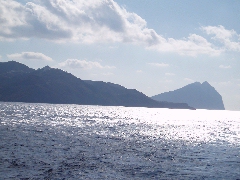
Anáfi from the sea, the typical profile of the island
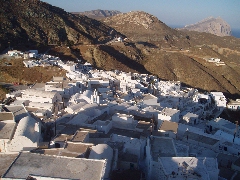
Panoramic view on Chóra

Chóra (view
from the sea)
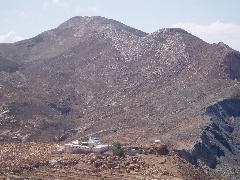
The beautiful situation of the monastery Zoödóchos Pigí
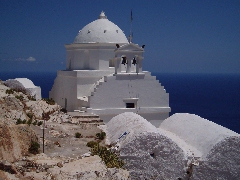
The Panagía i Kalamiótissa on Mount Kálamos
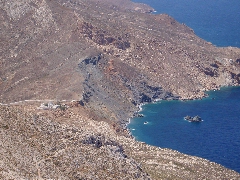
Panoramic view from the Panagía i Kalamiótissa
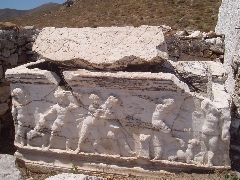
The Roman sarcophagus near the Panagía tou Dókari
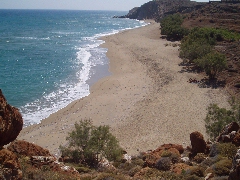
The nice beach of Roúkounas
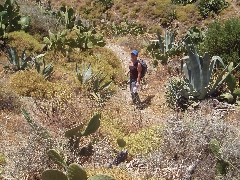
One of the few green spots on Anáfi